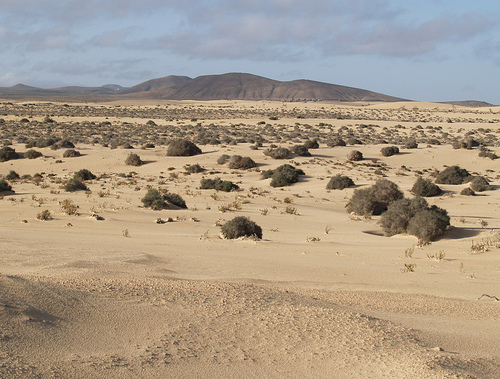| Home Page | The Island | Apartment facilities | Prices | Contact | Slideshow |
|---|
 Fuerteventura was formed about 70 million years ago as a result of volcanic activity. There are no active volcanos now but there is abundant evidence of their presence in the topology of the island as can be viwed from the Mirador (viewpoint) near Betancuria . For many tens of thousands of years sand from the Sahara has been deposited on Fuerteventura's shores. The result of this process is 125 miles of some of the world's best beaches. Some of the beaches have natural lagoons which stay calm even when the sea is rough. Visit El Cotillo for some good examples of the latter. In places the sand has been blown to create fantastic sand dunes which are a photographer's dream especially at dawn and dusk. The Corralejo Sand Dune Reserve is one such area.
Fuerteventura was formed about 70 million years ago as a result of volcanic activity. There are no active volcanos now but there is abundant evidence of their presence in the topology of the island as can be viwed from the Mirador (viewpoint) near Betancuria . For many tens of thousands of years sand from the Sahara has been deposited on Fuerteventura's shores. The result of this process is 125 miles of some of the world's best beaches. Some of the beaches have natural lagoons which stay calm even when the sea is rough. Visit El Cotillo for some good examples of the latter. In places the sand has been blown to create fantastic sand dunes which are a photographer's dream especially at dawn and dusk. The Corralejo Sand Dune Reserve is one such area.
You might be happy just to laze around the pool and relax but there is plenty to do on the island if you are the type who likes to explore or prefers to vary their itinerary. There are fantastic beaches to the south of Corralejo, El Cotillo and Jandia. Some have calm lagoons for swimming. Water sports are available in abundance - particularly surfing and kite boarding. Flag Beach near Corralejo and Sotavento south of Costa Calma are recommended. There are several good diving schools based on the harbour in Corralejo. The Water Park in Corralejo can provide hours of fun but check the months of opening. There are boat trips to Lobos Island where you can spend the day walking and swimming. Also there is a ferry to Lanzarote from Corralejo. Walking and cycling are well catered for. There are a number of bicycle/walking routes and bicycle hire is available. There are several good golf courses.
There are interesting old towns such as Betancuria and La Oliva. There are delightful old churches in most of these towns. Shopping in the larger towns is possible; Las Rotundas in Puerto del Rosario being particularly good for retail therapy! There are regular markets throughout the island. There are many interesting old buildings to visit such as the Colonels' House in La Oliva with its beautifully restored traditional woodwork. The island has a number of restored windwmills. The one in Antigua also has an interesting cactus garden and there is a Cheese Museum there too.
There is a working Salt Museum and Exhibition at Las Salinas just to the south of Caleta de Fuste. La Algocida is a working museum of traditional skills such as agriculture. The Fishing Museum at El Cotillo is situated in the old lighthouse - you can climb to the top for excellent views of the coastline.The apartment has an Information Folder, maps and leaflets giving details of how to access these and other attractions. A lot of them can be done by bus.